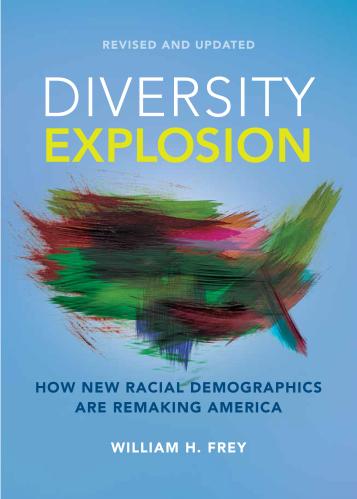On March 30 2021, Figure 2 was updated with correct data for Latino or Hispanic and Black projected race profiles.
As the new decade begins, a generational divide stands at the heart of our political debate, impacting a raft of issues including the current question on impeachment. For example, according to a recent Qunnipiac poll, 60% of registered voters under 35 believe the U.S. Senate should vote to remove President Trump from office—compared with just 42% of those over 50 who believe so.
In many ways, our racially diverse, younger population is beginning to flex its political muscle and raise national consciousness on a variety of progressive issues. This contrasts sharply with the rapidly aging population of mostly white baby boomers and their seniors, who have pushed back mightily against such policies. Unless some accommodation is reached, the struggle between our past and our future will persist, leaving our nation and its economy vulnerable.
The generational confrontation came to a head during the just-concluded decade, epitomized by the presidential transition from Barack Obama to Donald Trump. Obama, the nation’s first African American president, received solid support from voters under 45 and racial minority voters, signaling the rising political power of a younger, diverse America.
In a not-so-hidden backlash, white, working-class baby boomers and their seniors were the core constituency that subsequently elected Trump, who preyed upon their fears of a changing America with messages of nostalgia, isolationism, immigrant deportation, and rants against political correctness.
In his first three years in office, Trump’s administration has done much to curtail programs that benefit younger families—health care, benefits to immigrant children, public education, housing assistance, and many other social supports. And, alongside a Republican-controlled Congress, it has handcuffed future spending on such programs with irresponsible tax cuts, virtually guaranteeing ever-larger budget deficits.
Younger generations—millennials and Gen Zers—are strongly supportive of issues that would positively impact their futures: greater racial justice and inclusion, more favorable treatment of immigrants, stronger environmental protection, and effective gun control. But policies that support such measures are low on the priority list for Trump’s aging base.
Underlying this generational conflict are racial demographic dynamics which should further empower younger, diverse generations. One of these dynamics is the continued aging of the white population: There was an absolute decline in the number of white children and teenagers over the past decade, a consequence of there being fewer white women of childbearing age and low white immigration. Racial minorities, on the other hand, accounted for more than half of the decade’s births, as well as accounting for all growth in the country’s under-18 population.
Youthful diversity will be even more prominent in the new decade. The 2020 census will show that more than half of all children under 18 identify as a racial minority. During this new decade, as more white baby boomers age beyond 65, there will be an absolute decline of whites in their prime working years, meaning that racial minorities will contribute to all of the decade’s labor force growth.

The only part of America’s white population that will grow appreciably in the 2020s will be those of retirement age—increasing 23% over the next 10 years. This bulging, boomer-driven group will become increasingly dependent on a much slower-growing (2%) and rapidly diversifying labor force to support the federal programs that will benefit them, such as Social Security and Medicare. It is therefore vital for these boomers’ own interests to encourage government programs that benefit young families and future workers, including education and job training, Head Start, the Children’s Health Insurance Program, children’s nutrition, and child care assistance. Such programs will especially help children of color—many of them first- and second-generation Americans—who will soon contribute to our young adult and labor force populations.
However, diversity-driven demographic change will not necessarily alter politics if older, white boomers cannot be convinced to invest in America’s youth. While the 2020 census will show that 40% of the American population identifies as a minority, it is likely that white Americans will comprise about two-thirds of eligible voters (minorities are more likely than whites to be too young to vote or legal noncitizens) and more than seven in 10 actual voters in the 2020 election (whites, especially older whites, have the highest turnout rates). This voter gap will be even greater in places with high voter suppression and, for congressional elections, in states with gerrymandered districts.
If the political division between ages and races continues into the next decade, our social conflicts are sure to intensify. In 2030, the 50-and-under population—comprised of millennials and Gen Zers—is projected to be less than half white, nearly a quarter Latino or Hispanic, 14% Black, and 11% Asian American and other races, while the 65-and-older population will still over 70% white. Today’s oft-derisive and cynical cries of “white privilege” and “OK, boomer!” would likely escalate, and be more than justified if older whites continue to horde and benefit from the federal largesse while progressive polices to support criminal justice, immigrant rights, and racial equity are held at bay.

But these racial and generational identity politics do not have to continue. It is possible that older whites will eventually hold more generous attitudes toward today’s highly diverse younger generations as they age and disperse across the country into suburbs, exurbs, and currently red states, while the children and grandchildren of baby boomers marry those in other races. Millennials themselves can be positive role models as they age and take on leadership positions in business, politics, and public life, serving as a bridge generation between the boomer-dominated nation we have been and the multihued nation we are becoming.
Most importantly, if we are to keep our strength as a country, leaders of political parties and officials at all levels of government need to help their constituents understand the value of co-generational dependency between the old and the young. If this occurs, and I hope it does, the 2020s can be a decade of improved harmony and economic prosperity for Americans of all ages and races.
The Brookings Institution is committed to quality, independence, and impact.
We are supported by a diverse array of funders. In line with our values and policies, each Brookings publication represents the sole views of its author(s).







Commentary
The 2020s can end America’s generational divide in politics
Millennial and Gen Z voices need to be heard
January 28, 2020